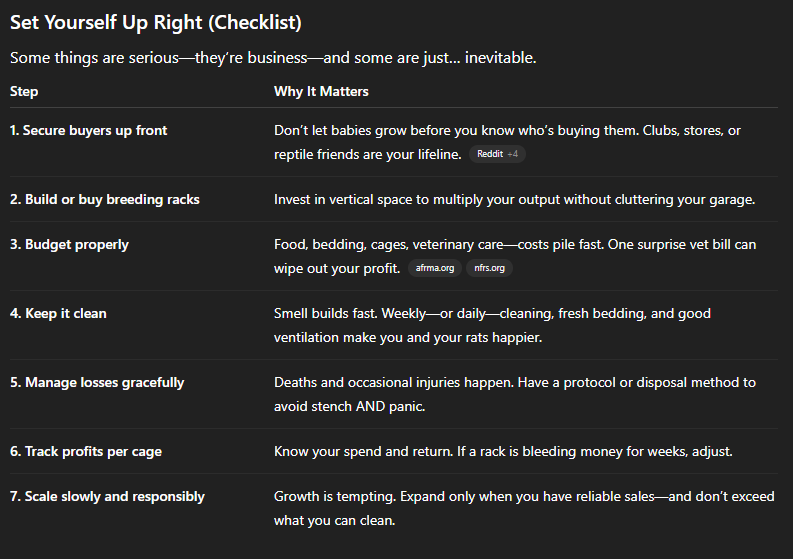How to Breed Rats for Profit (Even When You're Cleaning Poop)
Answer Box:
Breeding rats can be a side hustle or small business—if you manage costs, build relationships with buyers, and stay on top of the grimy details. With smart planning and the right gear, you might turn a small profit—but it’s no get-rich-quick scheme.
Introduction
Here's the truth nobody talks about clearly—breeding rats can be profitable, but only if you’re strategic, prepared, and undeterred by the less glamorous side of things: think poop-scooping, mourning half‑eaten bodies, and keeping those little escape artists in line. We'll guide you through how to set your breeding operation up, understand your costs and prices, and keep everything clean enough to sleep at night.
Who Is Breeding Rats (and Why)?
Not all breeders are the same:
Occasional Breeders begin with one pair and react when litters surprise them. They often give away babies to avoid the chaos.
Suppliers ramp up aggressively to “make money,” minimizing care to squeeze out profit.
Producers breed deliberately—selecting for traits, colors, volume.
Pet Providers focus on health and temperament, aiming for happy pet placements.
Bottom line: success depends on clarity—are you in it for volume, quality, or sanity?
Is There Real Money in This?
Some experiences go like this:
One breeder sells feeder rats to a local pet shop—20–40 rats per week, netting ~$205/month after ~$75/month in expenses.
Another small mouse breeder nets about $150/month after ramp-up.
But be warned. Many experienced breeders say the numbers don’t add up:
“If you want to breed rats to make money, forget it! The money … does not tend to cover costs”
“Breeding properly — you will lose money.”
Raising expectations is wise. You might break even—or pull in a modest chunk if optimized.
How Much Are Feeder Rats Worth?
Here’s what the market looks like for sellable rats:
Small feeders: about $3–$5 each depending on size
Frozen feeder rat prices range from $2.99 (pup) to $5.79 (medium) wholesale
Bulk retailer rates (live/frozen): about $0.85 (pinkies) to $2.75 each (medium), depending on quantity
So if you’re moving dozens a week, those small per-rat margins add up—though not to diamond-level wealth.
How to breed rats for profit checklist
A Little Brutal Honesty
Breeding rats is not all spreadsheets and cheery marketing. Expect:
Deep cleaning, often multiple times a week
Mourning the occasional lost litter—or the heart‑stopping moment of a half‑eaten body
Whiffs that haunt your dreams (and your visitors)
Balancing love of animals with business efficiency
In other words, the grind is real. But there’s pride in building something sustainable.
Final Thoughts
Set realistic expectations. If you treat this honestly—as a small hustle with smeared bedding and razor-thin margins—it can break even or inch toward profit. Scaling is where the opportunity lies—but so is the pain of managing more mess.
Do it smart, stay ethical, and watch the kittens—I mean, the rats—find their buyers.
Resources (for your readers)
Rodent breeding rack product page—stackable, rat-proof solutions
ASF mouse rack product page—space-saving and sturdy
Odds of profitability: AFRMA caution that serious breeding often doesn’t cover costs.
Community wisdom: One breeder nets ~$200/month after expenses.
Live pricing intel: Pet stores sell feeder rats in the $3–$5 range.

